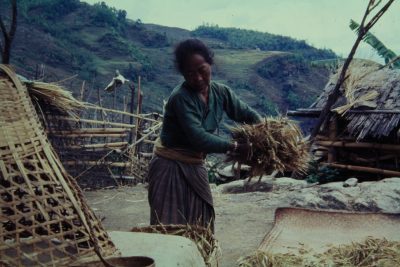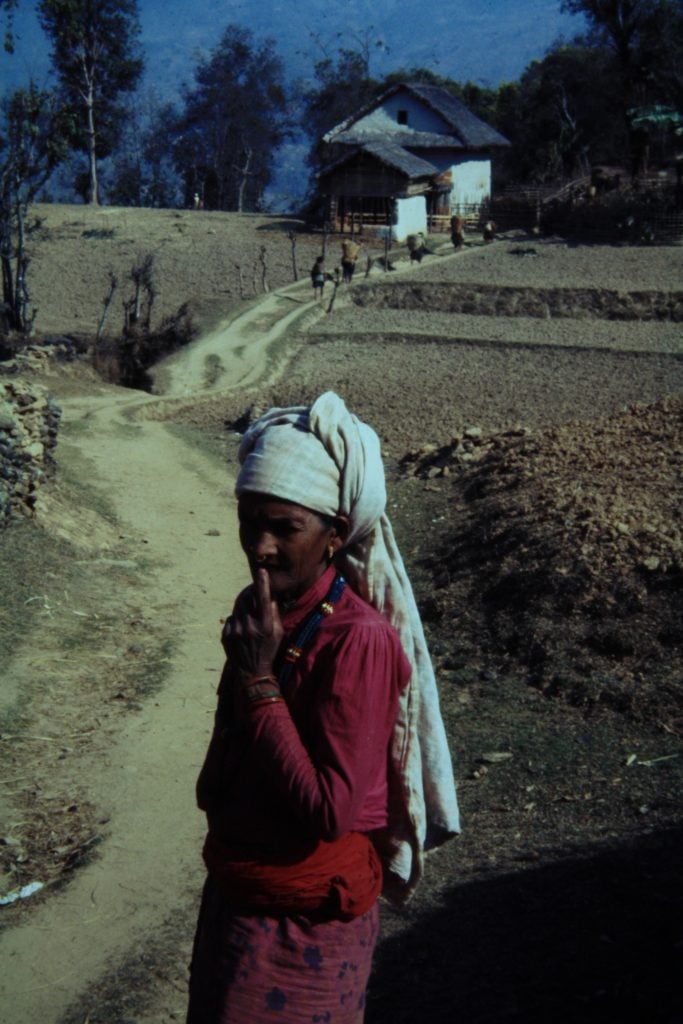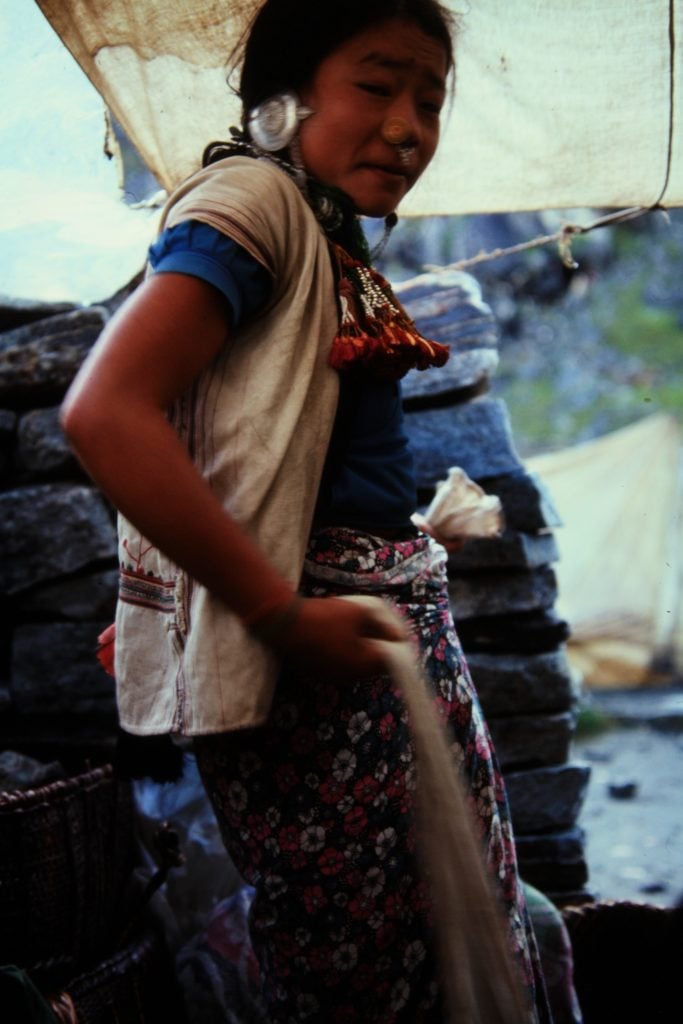Nepal Hill Art and Women’s Traditions
Part I

As I cull my writings, I find a few articles undeletable. Even as a historical portrait, some seem to be relevant today. In Nepal, land cultivation is declining as young people seek employment abroad to earn cash. Nepal, even for its poorer citizens, including farmers, has become a consumer economy. Meanwhile women continue to produce alcohol for sale and bead jewelry for a daughters’ marriage. This edited 1978 story will be posted in 3 parts.
PART 1: Chait Purnima, the full moon day (1977), reminds me a month has passed since my arrival here in Kobek village, a Himalayan hamlet in east Nepal. Light spring winds move over the trees and across clear swept courtyards, bringing with it the faint but reassuring voices of neighbors.
At the arrival of the full moon, fields empty of workers. People are freed from agricultural labor for the holiday, and today Danamaya’s neighbors will converge on our veranda. All women here are artisans. They weave the Limbu tartan cloth shawls and skirts worn by everyone, and they knot their own straw mats and baskets. Women are the brewers of beer and distilled spirits as well. Polishing rice and pressing oil are women’s skills too.
This full moon day, our neighborhood artisans will gather at my host’s doorway. They’ve been invited to help make a special ornament—for me.
During the better part of a year now, I’ve been moving around this eastern hill region, previously unknown to me, trying to understand rural economy. On a short stay a year earlier I met some Limbu people I’d only read about in anthropological literature. Limbu are an integral part of Nepal society yet very different from the Tibetan and Sherpa I was familiar with from previous research in Solu-Khumbu. Solu is three mountain ranges away, but hardly two hundred kilometers northwest (a ten day walk until the 1990s).
Exploitation of Limbu land rights by high-caste Brahmin villagers had been documented by my colleague Lionel Caplan. Limbu came to national attention as one of a handful of Nepal’s many ethnic groups to publicly criticize the government’s policy regarding minorities; that was during the monarchy when no dissent was tolerated. From medics and development officers impressed by Limbu culture, I also learned these women enjoy unusual economic independence. I decided to visit the area and learn more about them and their part of such a culturally and geographically diverse land.
Limbu would become one part of my limited comparative study of ethnic groups living near the primary north-south trade artery of east Nepal. I’d already surveyed a Sherpa community further north, and I stayed in a village inhabited by Newar and Tamang farmers. Limbu not only appear to be a physically quite different race; their rice cultivation and therefore their economy as well as their social values differ markedly. Living with Limbu, I often feel I might be in Burma or Thailand; whereas with Sherpa, one imbibes its underlying Tibetan flavor. I’ve already engaged with several Nepali cultures: the robust Sherpa herders and farmers, the richest of the highland peoples; progressive Newar traders and shopkeepers, many of whose daughters are in school; Rai hill people, a large ethnic group found in villages all across Nepal, also good farmers; Magar villagers who seem impoverished by the standard of other groups who dislodge them from their modest holdings; members of Brahman and Chetri higher castes, know for their frugality and industriousness, exert restrictions on women who often become ascetics and join riverside hermitages.
I announce my plan to take up residence in Kobek village and join a prosperous family of farmers, selecting a corner of an empty hayloft for myself behind the main house. It affords me the privacy I need while giving me easy access to the main house, where, as the weeks pass I spend almost all my time.
This residence is one of a cluster of two-story farmhouses on a steep hillside. Lemon bushes and groves of bamboo veil neighboring houses from one another. While familiar sounds, human and animal, bridge the boundaries between us.
The dark interiors of these dwellings are used for cooking, sleep and storage. Except to cook, no one works indoors. Routine domestic work proceeds on the veranda and in the cleanly swept courtyards in front. It’s here that villagers gather throughout pleasant, dry winter months and where work and social life are hardly distinguishable. With the arrival of spring, activity shifts from verandas to muddy fields on slopes above and below our village dwellings. Early wheat wants cutting and the earth in the patchwork of terraces must be broken so that tender millet and rice sprouts will take hold.
At Chait Purnima we have prepared for the arrival of seven women who’ll make a Limbu naugiri, a necklace of the nine (nau) golden jewels (giri) set among the mass of stringed beads. All Nepalis wear elaborate homemade jewelry, each culture with its own distinguishing design. Limbu women’s chunky naugiri necklace, worn day and night, in the fields, nursing their infants, to market, and at weddings, seems to express the general reputation of these women. They are known for their industry, their assertiveness, and pride. To me, the naugiri symbolizes that vigor and I want to take one with me when I leave them.
My interest in having my own naugiri delights my host Danamaya and other women. But where am I to obtain one? I wouldn’t want an old one bought from a bank, my friends assure me; those worn jewels have value only as security against land purchase loans. The women insist that I must have a new naugiri. But new necklaces cannot be purchased; they are not produced for a market. A Limbu woman’s naugiri is fabricated especially for her by others in her family at the time of her marriage. It’s decided that my surrogate family here in Kobek will make mine. (Never mind about a wedding.)
I commit myself to this scheme with the purchase of the key material—pure gold, costing about 500 Nepali rupees ($50.) on the Limbu market (at the time). This thola of gold (about half an ounce) I buy from a Kobek man recently returned from military service in Malaysia. Next, we visit the local goldsmith. His shabby hut is located on the edge of the village because he’s a member of a low ranked (out)caste. We find him seated on the second story veranda occupied with his trade. A regular stream of clients keeps him occupied, but he’s not too busy to accept my order; it will be ready in a few days. I visit him daily to observe him tap that worthless looking metal lump I’d entrusted to him into paper-thin lustrous yellow sheets. The precious metal emerges into its inert beauty in his outcasted hands. Finally he molds and engraves each of the nine leaves of gold into individual hollow spheres– my very own knuckly, assertive stones that will be the heart of my necklace.
Between each chunk, we women will set thousands of green glass beads. (I buy these at the weekly market, selected from the trays of dazzling bangles and beads imported from India and sold by rows of vendors seated on the roadside, each huddled around her wares.) I’m also directed to buy red felt cloth from which we will cut piece to be pressed like washers on either side of each golden ball. Finally, for the string we need to thread and arrange those beads, we unwind a length of yellow nylon rope cut from my backpack.
Originally published on Heresies, A Feminist Publication on Art and Politics, Jan/Feb, 1978.
All images in this article are from the author.



